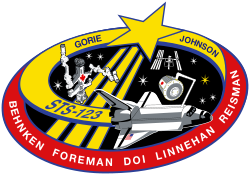Gregory H. Johnson
| Gregory Harold Johnson | |
|---|---|
 | |
| Astronaut NASA | |
| Státní příslušnost | USA |
| Datum narození | 12. května 1962 (61 let) |
| Místo narození | South Ruislip, Middlesex, Spojené království |
| Předchozí zaměstnání | zkušební pilot |
| Hodnost | plukovník USAF |
| Čas ve vesmíru | 31 dní, 11 hodin a 49 minut |
| Kosmonaut od | 1998 |
| Mise | STS-123, STS-134 |
| Znaky misí | |
| Některá data mohou pocházet z datové položky. | |
Gregory Harold Johnson (* 12. května 1962 v South Ruislip, Middlesex, Spojené království) je americký zkušební pilot a od roku 1998 astronaut NASA. V roce 2008 se zúčastnil jako pilot montážní mise STS-123 na Mezinárodní vesmírné stanici (ISS). Podruhé se do vesmíru dostal v roce 2011 při letu STS-134 k ISS.
Mládí a studia
Gregory Johnson se narodil 12. května 1962 v South Ruislip na okraji Londýna ve Spojeném království. V roce 1980 dokončil střední školu Park Hills High School ve Fairborn v Ohiu. V roce 1984 získal po studiu na U.S. Air Force Academy titul Bc. v oboru aerokosmické inženýrství. Roku 1985 po studiu na Kolumbijské univerzitě získal titul Master of Science. O dvacet let později ještě vystudoval na Texaské univerzitě v Austinu marketing a management.[1][2]
Oženil se s Cari Harbaughovou a mají spolu tři děti.
Vojenská kariéra
Kariéru v armádě zahájil v roce 1984, kdy se dostal k letectvu Spojených států, o dva roky později sloužil jako instruktážní pilot na letecké základně Reese AFB v Texasu na proudovém cvičném letounu T-38 Talon. V roce 1989 byl převelen do Seymour Johnson AFB v Severní Karolíně, kde působil jako stíhací pilot na F-15E Eagle. Při operaci Pouštní bouře uskutečnil 34 bojových letů a po skončení války v Zálivu ještě 27 letů v rámci podpůrných misí. V roce 1994 se stal zkušebním pilotem, specializoval se na stroje F-15 Eagle. Nalétal více než 4000 hodin.[1][2]
Astronaut

Do oddílu astronautů NASA byl vybrán 4. června 1998 a následně prodělal astronautický výcvik, který dokončil v roce 2000. Byl členem podpůrného týmu misí STS-100 a STS-108, týmu zkoumajícího vliv odpadávání pěny z nádrže ET na havárii raketoplánu Columbia.[1]
Do vesmíru se poprvé dostal v roce 2008. Mise STS-123 raketoplánu Endeavour dopravila k Mezinárodní vesmírné stanici japonský experimentální logistický modul ELM-PS a kanadský manipulátor SPDM. Gregory Johnson působil v posádce jako pilot, při výstupech astronautů do vesmíru obsluhoval robotické paže raketoplánu i stanice. Ve vesmíru na této misi strávil 15 dní a 18 hodin.[3]
Dne 16. května 2011 odstartoval Gregory Johnson jako pilot na svou druhou misi do vesmíru. Raketoplán Endeavour (STS-134) dopravil k ISS spektrometr AMS-02 (Alpha Magnetic Spectrometer) a nehermetizovanou plošinu ELC-3. Let trval 15 dní, 17 hodin a 38 minut, raketoplán se ze své historicky poslední mise vrátil na Kennedyho vesmírné středisko 1. června 2011.[4]
Odkazy
Reference
- ↑ a b c Biographical Data: Gregory H. Johnson (COLONEL, USAF, RET.) [online]. NASA, rev. březen 2011 [cit. 2011-05-28]. Dostupné v archivu pořízeném dne 2009-03-28. (anglicky)
- ↑ a b VÁCLAVÍK, Michal. STS-123 Endeavour - posádka [online]. Hvězdárna Vsetín, 2008-3-7 [cit. 2011-05-28]. Dostupné v archivu pořízeném dne 2014-03-14.
- ↑ Press Kit mise STS-123 [online]. NASA [cit. 2011-05-29]. Dostupné v archivu pořízeném dne 2008-06-24. (anglicky)
- ↑ HOLUB, Aleš. STS-134 En/F-25 [online]. Malá encyklopedie kosmonautiky (MEK), rev. 2011-6-2 [cit. 2011-06-06]. Dostupné online.
Externí odkazy
 Obrázky, zvuky či videa k tématu Gregory H. Johnson na Wikimedia Commons
Obrázky, zvuky či videa k tématu Gregory H. Johnson na Wikimedia Commons
Média použitá na této stránce
STS-123 continues assembly of the International Space Station (ISS). The primary mission objectives include rotating an expedition crew member and installing both the first component of the Japanese Experimental Module (the Experimental Logistics Module - Pressurized Section (ELM-PS)) and the Canadian Special Purpose Dexterous Manipulator (SPDM). In addition, STS-123 will deliver various spare ISS components and leave behind the sensor boom used for inspecting the shuttle's thermal protection system. A follow-on mission to ISS will utilize and then return home with this sensor boom. A total of five spacewalks are planned to accomplish these tasks. The mission will also require the use of both the shuttle and ISS robotic arms. STS-123 will utilize the Station-Shuttle Power Transfer System to extend the docked portion of the mission to eleven days, with a total planned duration of 15 days. The crew patch depicts the space shuttle in orbit with the crew names trailing behind. STS-123's major additions to ISS (the ELM-PS installation with the shuttle robotic arm and the fully constructed SPDM) are both illustrated. The ISS is shown in the configuration that the STS-123 crew will encounter when they arrive.
The design of the STS-134 crew patch highlights research on the International Space Station (ISS) focusing on the fundamental physics of the universe. On this mission, the crew of Space Shuttle Endeavour will install the Alpha Magnetic Spectrometer (AMS) experiment - a cosmic particle detector
NASA astronauts Mark Kelly (left), STS-134 commander; and Greg H. Johnson, pilot, occupy their respective stations on the forward flight deck of space shuttle Endeavour during rendezvous and docking operations with the International Space Station on flight day three.




